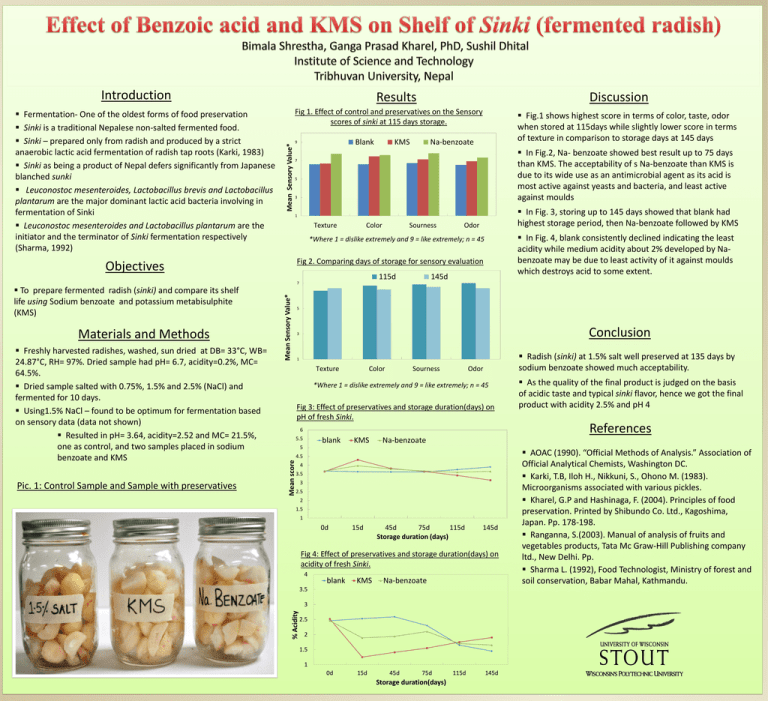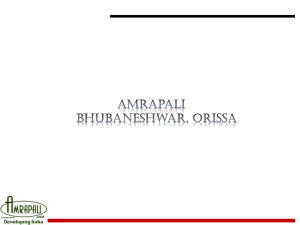Preparation and Preservation of Fermented Radish (Sinki)
advertisement

Introduction In Fig.2, Na- benzoate showed best result up to 75 days than KMS. The acceptability of s Na-benzoate than KMS is due to its wide use as an antimicrobial agent as its acid is most active against yeasts and bacteria, and least active against moulds 3 In Fig. 3, storing up to 145 days showed that blank had highest storage period, then Na-benzoate followed by KMS 1 Texture Color Sourness Odor In Fig. 4, blank consistently declined indicating the least acidity while medium acidity about 2% developed by Nabenzoate may be due to least activity of it against moulds which destroys acid to some extent. *Where 1 = dislike extremely and 9 = like extremely; n = 45 Fig 2. Comparing days of storage for sensory evaluation 115d 7 145d 5 Conclusion 3 Radish (sinki) at 1.5% salt well preserved at 135 days by sodium benzoate showed much acceptability. 1 Texture Color Sourness Odor *Where 1 = dislike extremely and 9 = like extremely; n = 45 Fig 3: Effect of preservatives and storage duration(days) on pH of fresh Sinki. As the quality of the final product is judged on the basis of acidic taste and typical sinki flavor, hence we got the final product with acidity 2.5% and pH 4 References 6 5.5 blank KMS Na-benzoate 5 4.5 4 3.5 3 2.5 2 1.5 1 0d 15d 45d 75d 115d Storage duration (days) 145d Fig 4: Effect of preservatives and storage duration(days) on acidity of fresh Sinki. 4 blank KMS 0d 15d Na-benzoate 3.5 3 % Acidity Pic. 1: Control Sample and Sample with preservatives Na-benzoate 5 Mean score Freshly harvested radishes, washed, sun dried at DB= 33°C, WB= 24.87°C, RH= 97%. Dried sample had pH= 6.7, acidity=0.2%, MC= 64.5%. Dried sample salted with 0.75%, 1.5% and 2.5% (NaCl) and fermented for 10 days. Using1.5% NaCl – found to be optimum for fermentation based on sensory data (data not shown) Resulted in pH= 3.64, acidity=2.52 and MC= 21.5%, one as control, and two samples placed in sodium benzoate and KMS KMS Fig.1 shows highest score in terms of color, taste, odor when stored at 115days while slightly lower score in terms of texture in comparison to storage days at 145 days 7 Mean Sensory Value* Materials and Methods Blank 9 Objectives To prepare fermented radish (sinki) and compare its shelf life using Sodium benzoate and potassium metabisulphite (KMS) Discussion Fig 1. Effect of control and preservatives on the Sensory scores of sinki at 115 days storage. Mean Sensory Value* Fermentation- One of the oldest forms of food preservation Sinki is a traditional Nepalese non-salted fermented food. Sinki – prepared only from radish and produced by a strict anaerobic lactic acid fermentation of radish tap roots (Karki, 1983) Sinki as being a product of Nepal defers significantly from Japanese blanched sunki Leuconostoc mesenteroides, Lactobacillus brevis and Lactobacillus plantarum are the major dominant lactic acid bacteria involving in fermentation of Sinki Leuconostoc mesenteroides and Lactobacillus plantarum are the initiator and the terminator of Sinki fermentation respectively (Sharma, 1992) Results 2.5 2 1.5 1 45d 75d Storage duration(days) 115d 145d AOAC (1990). “Official Methods of Analysis.” Association of Official Analytical Chemists, Washington DC. Karki, T.B, Iloh H., Nikkuni, S., Ohono M. (1983). Microorganisms associated with various pickles. Kharel, G.P and Hashinaga, F. (2004). Principles of food preservation. Printed by Shibundo Co. Ltd., Kagoshima, Japan. Pp. 178-198. Ranganna, S.(2003). Manual of analysis of fruits and vegetables products, Tata Mc Graw-Hill Publishing company ltd., New Delhi. Pp. Sharma L. (1992), Food Technologist, Ministry of forest and soil conservation, Babar Mahal, Kathmandu.







